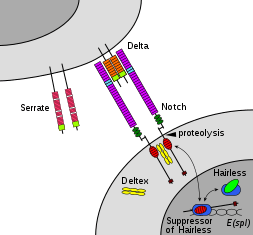Juxtacrine signalling
In biology, juxtacrine signalling (or contact-dependent signalling) is a type of cell–cell or cell–extracellular matrix signalling in multicellular organisms that requires close contact. Hence, this stands in contrast to releasing a signaling molecule by diffusion into extracellular space, the use of long-range conduits like membrane nanotubes and cytonemes (akin to 'bridges') or the use of extracellular vesicles like exosomes or microvesicles (akin to 'boats'). There are three types of juxtacrine signaling:
- A membrane ligand (protein, oligosaccharide, lipid) and a membrane protein of two adjacent cells interact.
- A communicating junction links the intracellular compartments of two adjacent cells, allowing transit of relatively small molecules.
- An extracellular matrix glycoprotein and a membrane protein interact.

Additionally, in unicellular organisms such as bacteria, juxtacrine signaling refers to interactions by membrane contact.
Juxtacrine signaling has been observed for some growth factors, cytokine and chemokine cellular signals, playing an important role in the immune response. It has a critical role in development, particularly of cardiac and neural function. Other types of cell signaling include paracrine signalling and autocrine signalling.
The term "juxtacrine" was originally introduced by Anklesaria et al. (1990) to describe a possible way of signal transduction between TGF alpha and EGFR.[1]
Cell–cell signaling
In this type of signaling, a cell places a specific ligand on the surface of its membrane, and subsequently another cell can bind it with an appropriate cell surface receptor or cell adhesion molecule. An important example is the Notch signaling pathway, notably involved in neural development.[2]
Communicating junctions
Two adjacent cells can construct communicating conduits between their intracellular compartments: gap junctions in animals and plasmodesmas in plants.[2][3]
Gap junctions are made of connexins in vertebrates and innexins in invertebrates. Electrical synapses are electrically conductive gap junctions between neurons. Gap junctions are critical for cardiac myocytes, mice and humans deficient in a particular gap junction protein have severe heart development defects.[4]
Cell–extracellular matrix signaling
The extracellular matrix is composed of glycoproteins (proteins and mucopolysaccharides (glycosaminoglycan)) produced by the organism's cells. They are secreted not only to build a supportive structure but also to provide critical information on the immediate environment to nearby cells. Indeed, the cells can themselves interact by contact with extracellular matrix molecules and as such, this can be considered an indirect cell / cell communication.[2] Cells use mainly the receptor integrin to interact with ECM proteins. This signaling can influence the cell cycle and cellular differentiation.[5]
In unicellular organisms
In addition to releasing signaling molecules into their environment to initiate quorum sensing, bacteria can use contact-dependent signaling through different mechanisms, for such purpose as to inhibit their growth in harsh conditions.[6][7]
See also
- Cell adhesion, mechanical adhesion between cells and/or the extracellular matrix
- Role of cell adhesions in neural development
- Cell adhesion molecules
- Pannexin, vertebrate proteins used to form conduits between the intracellular and extracellular space
- Autocrine signalling
- Paracrine signalling
- Endocrine system
References
- Anklesaria, P; Teixidó, J; Laiho, M; Pierce, JH; Greenberger, JS; Massagué, J (May 1990). "Cell-cell adhesion mediated by binding of membrane-anchored transforming growth factor alpha to epidermal growth factor receptors promotes cell proliferation". Proceedings of the National Academy of Sciences of the United States of America. 87 (9): 3289–93. doi:10.1073/pnas.87.9.3289. PMC 53885. PMID 2333283.
- Gilbert, Scott F. (2000). "Juxtacrine Signaling". In NCBI bookshelf (ed.). Developmental biology (6. ed.). Sunderland, Mass.: Sinauer Assoc. ISBN 0878932437.
- Crawford, KM; Zambryski, PC (October 1999). "Plasmodesmata signaling: many roles, sophisticated statutes" (PDF). Current Opinion in Plant Biology. 2 (5): 382–7. doi:10.1016/s1369-5266(99)00009-6. PMID 10508755.
- Bruce Alberts; et al. (2002). "General Principles of Cell Communication". In NCBI bookshelf (ed.). Molecular biology of the cell (4th ed.). New York: Garland Science. ISBN 0815332181.
- Giancotti, FG; Ruoslahti, E (Aug 13, 1999). "Integrin signaling". Science. 285 (5430): 1028–32. doi:10.1126/science.285.5430.1028. PMID 10446041.
- Aoki, SK; Pamma, R; Hernday, AD; Bickham, JE; Braaten, BA; Low, DA (Aug 19, 2005). "Contact-dependent inhibition of growth in Escherichia coli". Science. 309 (5738): 1245–8. Bibcode:2005Sci...309.1245A. doi:10.1126/science.1115109. PMID 16109881.
- Blango, Matthew G; Mulvey, Matthew A (31 March 2009). "Bacterial landlines: contact-dependent signaling in bacterial populations". Current Opinion in Microbiology. 12 (2): 177–181. doi:10.1016/j.mib.2009.01.011. PMC 2668724. PMID 19246237.
External links
- "Autocrine versus juxtacrine signaling modes" - illustration at sysbio.org